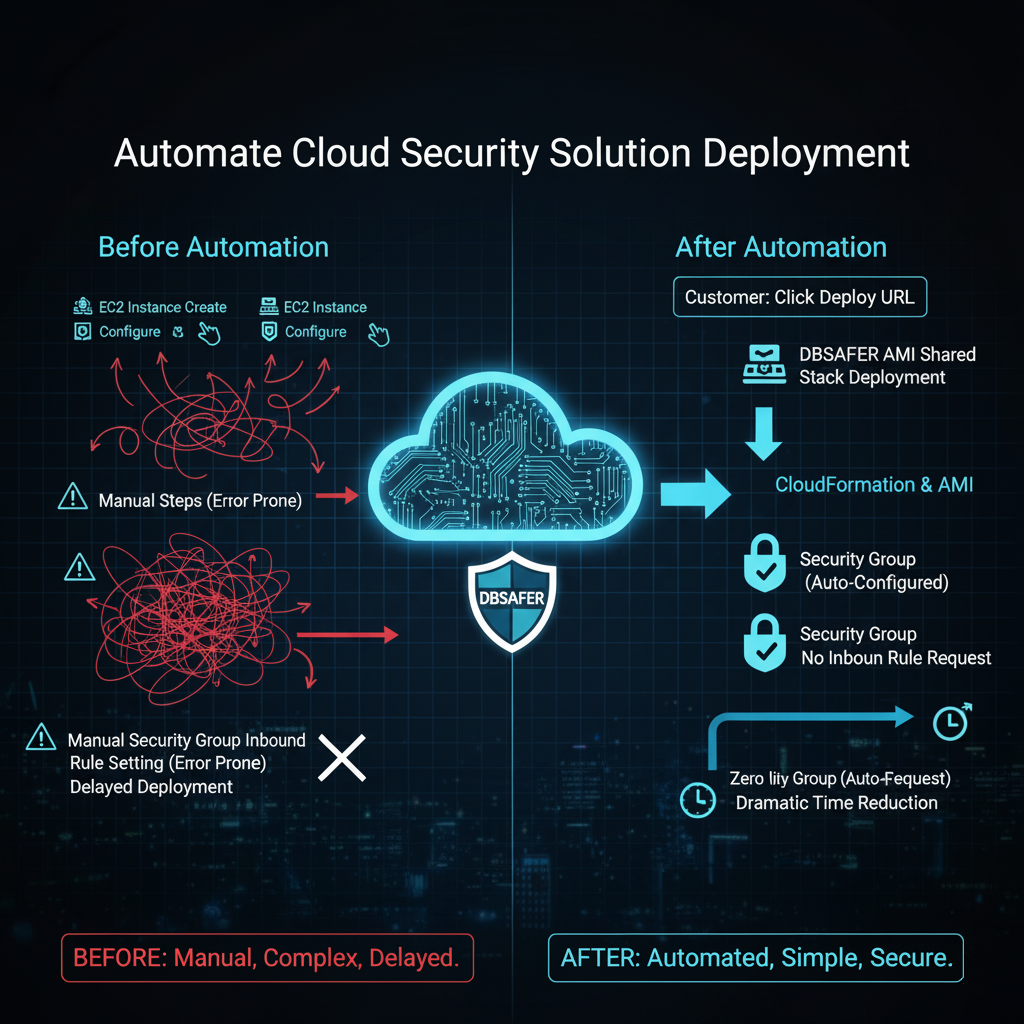IaC-Based Automated Deployment of DBSAFER Stack
Demonstration of IaC-based automated deployment of DBSAFER in AWS achieving zero installation effort and improved customer experience

Introduction
Providing security solutions in the cloud as a subscription service goes beyond merely changing the installation method. It redefines both the customer experience and operational efficiency.
In environments such as financial, public, and large enterprises, high and complex security standards persist. Without simplified infrastructure deployment, customer burden remains.
This case study discusses an automated deployment architecture designed to deliver DBSAFER as a subscription service in AWS. The key achievement was zero engineer installation effort, demonstrating an evolution in service delivery models.
Background
Initially, customers subscribing to the security solution required multiple manual steps for installation:
- Creating EC2 instances in the customer’s AWS account
- Sharing access credentials with engineers
- Configuring remote access environments
- Engineers installing packages manually on the instance
One recurring challenge was configuring security group inbound rules. While requests for opening required ports sometimes proceeded smoothly, delays or incorrect settings occurred frequently. This often extended installation schedules or caused unstable initial environments.
To reduce these repetitive burdens and potential errors, AWS native tools—AMI and CloudFormation—were adopted for a new deployment approach.
Implementation

AMI Sharing
Upon a subscription request, engineers receive the customer’s AWS Account ID and grant DBSAFER AMI usage permissions.
Customers do not need to receive separate installation files; a standardized image is provided directly.
CloudFormation Stack Deployment
Engineers provide customers with a CloudFormation stack deployment URL.
With a few clicks, customers can:
- Select VPC and Subnet
- Specify EC2 instance type
- Configure security groups
The DBSAFER server and required network resources are automatically deployed with minimal input.
Deployment Outcome
When CloudFormation executes:
- EC2 instances are created
- Security groups, IAM roles, and network configurations are automatically provisioned
Inbound security group rules required for DBSAFER operation are applied automatically, removing the need for customer personnel intervention.
This significantly reduced installation delays and configuration errors, providing a smoother deployment experience.
Scalability and Demonstration
This approach extends beyond installation automation.
- Leveraging AWS SaaSBoost, the solution was expanded into a siloed SaaS model
- Collaboration with AWS developers enabled further optimization
- DBSAFER was demonstrated at AWS Summit and registered in a Private Market
Although public release requires organizational strategy decisions, technical validation has already been achieved.
Benefits
Zero Installation Effort
Engineers no longer need to install directly.
Customers can achieve the same results with only their Account ID and the deployment URL. Installation time has been drastically reduced.
Standardized Customer Experience
Environmental variations are eliminated, ensuring consistent deployment quality.
Automatic security group configuration removes delays and errors caused by manual rule management. This improves operational stability from initial setup.
Operational Efficiency
Engineers can focus on high-value activities such as operations and consulting rather than repetitive installation tasks.
Quantitative outcomes:
- 2023 total deployments: ~120
- 2024 total deployments: ~170 (+50 increase)
- Personnel input decreased by 1.5 FTE despite increased deployment volumes on other CSPs
The efficiency gain was directly attributable to CloudFormation stack deployment introduced in 2024.
Scalability
SaaSBoost-based siloed model, Summit demonstration, and Private Market registration show that DBSAFER can expand into a cloud-native SaaS model beyond mere automated installation.
Conclusion
The IaC-based DBSAFER stack automated deployment case demonstrates practical improvement by achieving zero engineer installation effort.
AMI and CloudFormation simplified customer experience, and SaaSBoost-enabled expansion validated the service delivery model.
Even with increased deployment volumes in 2024, fewer personnel handled operations efficiently, highlighting an operational efficiency improvement that elevates the cloud-based security solution delivery model.
